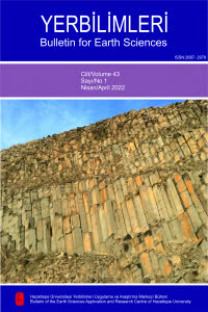Sürekli Dalgacık Dönüşümü Kullanılarak Manyetik Kaynakların Yatay Konumlarının ve Derinliklerinin Belirlenmesi
Magnetic anomalies, continuous wavelet transform, local maxima, source position
Determination of Horizontal Locations and Depths of Magnetic Sources Using Continuous Wavelet Transform
___
- Aydın, İ. , 2008. Maden Arama Jeofiziği Ders Notları 1.Bölüm (Gravite-Manyetik). Ge- nişletilmiş 2.Yazım, Ankara.
- Boztuğ, D., 1998. Post-collisional Central Anato- lian alkaline plutonism, Turkey. Turkish Journal of Earth Sciences 7, 145–16.
- Göncüoğlu, M. C., Toprak, V., Erler, A. and Kus- ca, I. 1991. Orta Anadolu masifi batı kesiminin jeolojisi, Bölüm 1:Güney ke- sim. TPAO Rap., No.2909, 176 pp. (in Turkish)
- Görür, N., Oktay F.Y., Seymen, I. and Şengör, A.M.C. 1984. Paleotectonic evolution of Tuz Golu basin complex, central
- Turkey. In the Geological Evolution of
- the Eastern Mediterranean, (J.E,Dixon
- and A.H.F. Robertson, eds.), Geol. Soc.
- Spec. Publ., 17, Blackwell, Oxford, 81- 96.
- Gunn, P. J., 1975. Linear transformations of gravity and magnetic fields. Geophys. Prosp. 23 300–312
- Hartman, R. R, Teskey, D. J., and Friedberg, J. L., 1971. A system for rapid digital ae- romagnetic interpretation. Geophysics 36 891-918
- Holschneider, M., 1995. Wavelets: An Analysis
- Tool. New York: Oxford University Press
- Honby P, Boschetti, F. and Horovitz, F. G. 1998. Analysis of potential field data in the wavelet domain, Geophys. J. Int., 137, pp 175–196
- Hsu, S., Sibuet, J., and Shyu, C., 1996. High- resolution detection of geologic boun- daries from potential-field anomalies: An enhanced analytic signal technique. Geophysics 61 373–386
- Hsu, S., Coppens, D., and Shyu, C., 1998. Depth to magnetic source using the generalized analytic signal. Geophysics 63 1947–1957.
- Kumar, P. and Foufoula-Georgiou, E., 1997. Wavelet analysis for geophysical app- lications. Reviews of Geophysics 35 385–412.
- Kuşcu, İ., and Erler, A., 1998. Mineralization Events in a Collision-Related Setting:
- The central Anatolian Crystalline Comp
- lex, Turkey. International Geology Revi- ew 40 532-565.
- Moreau, F., Gibert, D., Holschneider, M., Sarac- co, G., 1997. Wavelet analysis of poten- tial fields. Inverse Problem 13 165–178.
- Moreau, F., Gibert, D., Holschneider, M., and Saracco, G., 1999. Identification of so- urces of potential fields with the conti- nuous wavelet transform: Basic theory,
- J. Geophys. Res., 104, 5003–5013.
- Nabighian, M. N., 1984. Toward a three-dimen- sional automatic interpretation of po- tential field data via generalized Hilbert transforms: Fundamental relations. Ge- ophysics 49, 780–786.
- Ouadfeul, S., 2006. Automatic lithofacies seg- mentation using the wavelet transform modulus maxima lines (WTMM) com- bined with the detrended fluctuation analysis (DFA), 17th International Ge- ophysical Congress and Exhibition of
- Turkey, Expanded abstract.
- Ouadfeul, S. and Aliouane, L., 2010. Multiscale of 3D GPR data using the continuous wavelet transform IEEE, doi: 10.1109/ ICGPR.2010.5550177 1-4.
- Reid, A. B., Allsop, J. M., Granser, H., Milett, A.
- J., and Somerton, I., 1990. Magnetic
- interpretation in tree dimensions using
- Euler deconvolution. Geophysics 55, 80–91.
- Roest, W. R., Verhoef, J., and Pilkington, M.,
- 19 Magnetic interpretation using the 3-D analytic signal. Geophysics 57 116–125.
- Sailhac P, Galdeano A, Gibert D, Moreau F and Delor C 2000 Identification of sources of potential fields with the continuous wavelet transform: Complex wavelets and applications to magnetic profiles in French Guiana, J. Geophys. Res., 105, 19,455– 19,475.
- Smith, R. S., Thurston, J. B., Dai, T. F., and MacLeod, I. N., 1998. iSPI™ the impro- ved source parameter imaging method: Geophys. Prosp. 46 141–151.
- Stavrev, P. Y ., 1997. Euler deconvolution using differential similarity transformations of gravity or magnetic anomalies. Geoph- ysical Prospecting 45, 207–246.
- Thompson, D. T., 1982. EULDPH: A technique for making computer assisted depth estimates from magnetic data. Geoph- ysics 47 31–37.
- Thurston, J. B. and Smith, R. S., 1997. Auto- matic conversion of magnetic data to depth, dip, and susceptibility contrast using the SPITM method. Geophysics 62, 807–813.
- Won I. J. and Bevis M., 1987. Computing the gravitational and magnetic anomali- es due to a polygon: Algorithms and Fortran subroutines, Geophysics, 52, 232–238. Düzeltme (Erratum)
- Dergimizin 34/1 Nisan 2013 sayısında yer alan
- “Yapay Sinir Ağı Yöntemi ile Manyetotellürik
- Veride Sinyal ve Gürültü Ayırımı “ başlıklı maka
- lenin iletişim kurulacak yazarı Ebru Şengül ULU
- OCAK olup, iletişim adresi : ebrusengul@gmail.
- com olarak düzeltilmiştir. Bu aksaklık için sayın
- yazarımızdan özür dileriz.
- ISSN: 1301-2894
- Yayın Aralığı: 3
- Başlangıç: 1976
- Yayıncı: Hacettepe Üniversitesi Yerbilimleri Uygulama ve Araştırma Merkezi
Alaköy fayı’nın jeomorfolojik özellikleri ve tektonik etkinliği (Van Gölü Havzası – Doğu Anadolu)
Türkiye ve Yakın Çevresinin Aktif Fayları Veri Bankası ve Deprem Tehlikesinin Araştırılması
Hilal YALÇIN, LEVENT GÜLEN, MURAT UTKUCU
Alaköy Fayının Jeomorfolojik Özellikleri ve Tektonik Etkinliği (Van Gölü Havzası Doğu Anadolu)
